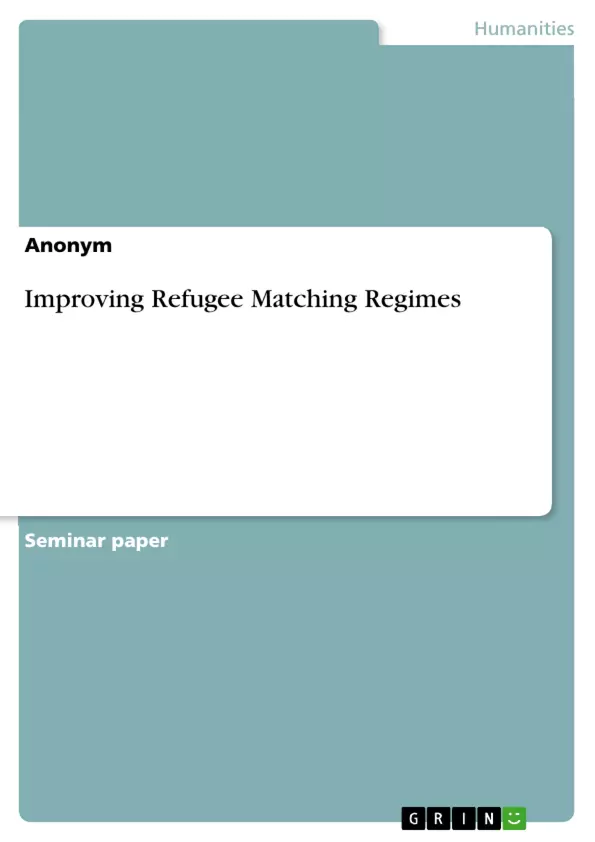According to Andersson (2017), there are two distinct categories to refugee assignment: the first is assignment through resettlement schemes, i.e., the authorities have information about the number of refugees that will need to be allocated within a specific time interval as well as the refugees’ characteristics. This is known as a static assignment. The other is for those refugees that directly arrive at a location, also known as asylum seekers, without a resettlement scheme, these are dynamic assignments. The introduction of dynamics results in uncertainty around the number of refugees that need to be allocated within the market. In this paper, we intend to explore two approaches suggested by Andersone et al. (2018) and Delacretaz, Kominers, & Teytelboym (2016). We will further discuss how these algorithms compare to those currently in place.
The global refugee population was estimated to be as high as 25.9 million at the end of 2018, up from 10.5 million in 2012, which represents an ever-growing global refugee market. The top ten countries of origin account for 82 percent of all refugees, or 16.6 million in 2018. Each year, there are over 3.5 million asylum seekers, with most going to the USA, Turkey, and Germany. This, together with the overall increase in demand for allocations, means that much more emphasis must be placed on the improvement of current mechanisms to make refugee allocations more efficient and cost-effective for all parties involved.
Inhaltsverzeichnis (Table of Contents)
- Introduction to Market
- Discussion of Matching Models
- Delacretaz, Kominers, and Teytelboym (Multidimensional Matching)
Zielsetzung und Themenschwerpunkte (Objectives and Key Themes)
This paper aims to explore the potential of algorithms in improving refugee matching regimes, focusing on the relative merits of different approaches. It aims to understand the complexities of multidimensional matching, considering factors beyond just nationality, and to evaluate how these algorithms compare to current practices in refugee resettlement.
- The complexities of multidimensional matching in refugee allocation
- The importance of considering factors such as family composition, healthcare needs, and language skills
- The limitations of traditional matching models for refugee resettlement
- The potential benefits of algorithms sensitive to service demand and provision
- The trade-off between satisfying refugee preferences and local priorities
Zusammenfassung der Kapitel (Chapter Summaries)
Introduction to Market
This section outlines the growing global refugee population, highlighting the need for efficient and cost-effective refugee allocation mechanisms. It distinguishes between static and dynamic refugee assignments, highlighting the inherent complexities of matching refugees to locations.
Discussion of Matching Models
This chapter discusses the limitations of traditional matching models, like Top-Trading Cycles and the Deferred Acceptance algorithm, when applied to refugee allocations. It emphasizes the multidimensional nature of the problem, requiring consideration of multiple factors beyond basic preferences. The chapter also explores the desirable attributes of stability, efficiency, and strategy-proofness in the context of refugee matching, highlighting the challenges of achieving them in practice.
Delacretaz, Kominers, and Teytelboym (Multidimensional Matching)
This section introduces the multidimensional matching framework proposed by Delacretaz, Kominers, and Teytelboym (2016). It emphasizes the importance of considering service demand and provision in refugee matching. The chapter delves into the Multidimensional Top Trading Cycles (MTTC) algorithm, highlighting its potential for achieving Pareto-efficient results and strategy-proofness. It also discusses the limitations of the MTTC algorithm, particularly its reliance on satisfying refugee preferences over local priorities. This leads to the introduction of the Serial Multidimensional Top Trading Cycle (SMTTC) algorithm, offering a more balanced approach to balancing refugee preferences and local priorities. Finally, the chapter mentions the Top Choice algorithm, which aims to find a stable outcome in cases where both refugee preferences and local priorities are considered.
Schlüsselwörter (Keywords)
This paper focuses on key terms such as refugee matching, multidimensional matching, algorithm design, service demand and provision, Pareto-efficiency, strategy-proofness, stability, refugee resettlement, and refugee preferences. The paper investigates how these concepts interrelate and their potential impact on improving refugee matching regimes.
- Quote paper
- Anonym (Author), 2019, Improving Refugee Matching Regimes, Munich, GRIN Verlag, https://www.grin.com/document/1289866



